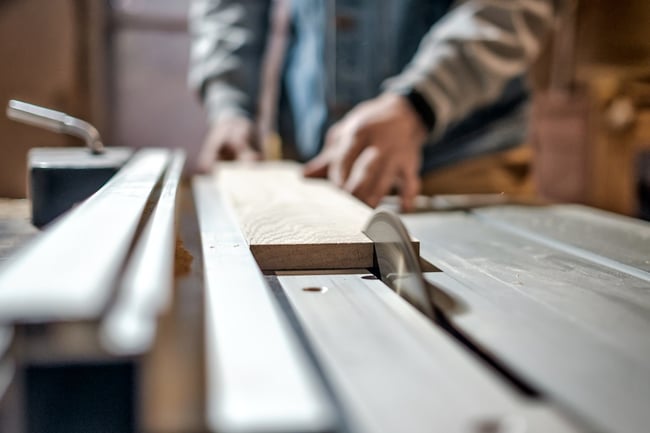August 25, 2021 | Lean, ISO
Top 10 Methods for Reducing Labor Costs
Labor costs are often one of the largest line items on your company balance sheet. Therefore, a successful cost reduction strategy must adequately balance resourcing and cost controls. Luckily, there are a variety of direct and nuanced methods to help improve your manufacturing company’s bottom line; read on to learn more about these methods for reducing labor costs, as well as why reduced production costs add value to your organization.
Quick Links:
Ten Methods For Reducing Labor Costs
While there are a variety of approaches towards reducing labor costs, these strategies are designed to maximize the productivity of your labor force while cutting out expenses.
1. Enhance Safety
It is wise for manufacturers to continuously work to improve safety within their facilities - and these efforts pay off. The U.S. Bureau of Labor Statistics reports that the number of manufacturing injuries has decreased considerably over the years, from seven injury cases per 100 people in 2003 to just four cases per 100 people in 2016.
Ultimately, your employees are your most valuable assets; nothing can happen without them! Make sure you’re providing them a clean, healthy, and safe work environment. Implementing best-in-class safety protocols can reduce the chance of accidents and costly workers’ compensation claims.
2. Provide Excellent Training
A well-trained workforce enhances productivity and reduces re-work. Establish a training plan for employees that includes both initial training to ensure they quickly get up to speed, and ongoing training to ensure employees stay current. Excellent training also means your workforce is employing the best practices for whatever their role is, and can take further initiative in their position.
3. Reduce Employee Turnover and Increase Productivity
It costs far more to replace an employee than to retain great employees. So, take the time to invest in keeping your staff happy. Whatever your manufacturing organization produces, you’re focused on making a quality product or providing top-notch service. But to do that, you need to attract quality talent, retain those workers, and use emerging technology to empower a smarter workforce.
4. Cost Reduction by Design
A general rule of thumb is that your manufacturing organization has locked in 70 – 95 % of your product cost after you have completed 5% of the product design. Therefore, manufacturers who also design products can save a significant amount of money on parts, materials, quality, and labor by considering cost reduction during the design phase of the product.
Several of the most important considerations include:
- Design for Manufacturability: This involves considering manufacturing issues - such as raw material selection, secondary processes, dimensional requirements, and even the final packaging - at the concept stage to reduce material, overhead, and labor costs.
- Design for Lean: Lean design is ideal for companies that have high production values tied to labor costs. Manufacturers can consider factors such as design simplification, design for assembly, and standardizing processes to reduce direct labor costs.
- Design for Quality: This assures high quality and reliability within the products to eliminate rework, which increases labor costs per unit.
5. Eliminate Overscheduling
Overscheduling is a considerable source of avoidable labor costs in any operation. When management has access to imperfect information about the production demands, their scheduling is just a "best guess." However, using predictive scheduling software based on sophisticated algorithms, you can optimize your employee scheduling efforts.
With this software, managers can look ahead at the incoming production demand and make the scheduling decisions from that data. This ensures the business is adequately staffed to meet the demand and eliminates excessive/unnecessary labor hours. Utilizing scheduling software also helps your employees - studies show that 70% of workers’ schedules have been changed last minute, which disrupts their personal and financial lives.
6. Lean Production
Lean production eliminates non-value added processes within manufacturing. When implemented and fully embraced in the company, lean production improves and can even double labor productivity, reduces inventory, and cuts production throughput times significantly. Essentially, with a more efficient production process, employees can produce more units—thus lowering your labor cost per unit.
In addition to eliminating non-value-added processes, lean production also helps eliminate bottlenecks within the typical production line.

7. Standardization
Process and part standardization can result in economies of scale and boost overall production. Standardization means that your employees have an established, time-tested process to use. When done well, standardization can decrease ambiguity and guesswork, guarantee quality, boost productivity, and increase employee morale since the process is consistently successful.
Any complex task is likely to have some gray areas or edge cases; the trouble with this is that time spent on guesswork is time wasted. With a clear set of instructions to work from in order to complete a task, employees will spend less time trying to figure it out and more time actually doing it.
8. Technology Implementation
Furthermore, with technological advances that aid in automation, there are some jobs where machines can do the work of a human more efficiently and effectively. Systems such as automated inspection, automated picking of components for assembly, and automated assembly will all aid in reducing labor costs in manufacturing.
9. Utilizing Part-Time Labor
By utilizing part-time labor, you are not paying for benefits, 401K contributions, bonuses, and other perks that a full-time employee may be receiving. Many companies use “on-call” employees as a method of reducing labor costs in manufacturing. The on-call system involves open scheduling whereby employees can come to work when they need to make money; employees are trained in specific jobs so they can contribute whenever work is available.
10. Change Your Manufacturing Process or Layout
When was the last time you reviewed your manufacturing process or layout to maximize productivity? Advances in technology and workforce skills might enable modifications that can boost productivity, optimize manufacturing space and reduce labor costs.
There are several important parts of a manufacturing operation often referred to as “TIMWOOD.” The acronym refers to the following to review to uncover possible waste factors:
- Transport – minimize movement of materials so processes are near each other
- Inventory (Stock) – aim for just-in-time production
- Motion – improve workplace ergonomics and reduce unnecessary motion of business operations
- Waiting – aim for a smooth flow to eliminate waiting periods
- Overproduction – aim to make what the customer orders, not more, just in time
- Overprocessing – use resources of appropriate capacity to achieve the required quality
- Defects – aim for zero defects
- Skills (Unused) – not using the full potential of staff by wasting their knowledge, experience, and ideas

Learn More About Reducing Your Labor Costs With CMTC
Labor costs are a significant portion of the budget for any company. However, there are ways to streamline the process which aids in reducing labor costs in manufacturing. CMTC’s team of qualified consultants is made up of diverse backgrounds and skillsets to provide the knowledge necessary to overcome almost any issue faced by California’s manufacturing community. CMTC specializes in technical assistance, workforce development, and consulting services for small and medium-sized manufacturers. We can help you implement industry best practices in your factory.
For more information on CMTC’s services or to reach out to one of our manufacturing experts, contact CMTC today.
About the Author
Gregg Profozich
Gregg Profozich is a manufacturing, operations and technology executive who believes that manufacturing is the key creator of wealth in the economy and that a strong manufacturing sector is critical to our nation’s prosperity and security now, and for future generations. Across his 20-year plus career in manufacturing, operations and technology consulting, Mr. Profozich helped manufacturing companies from the Fortune 500 to the small, independents significantly improve their productivity and competitiveness.

